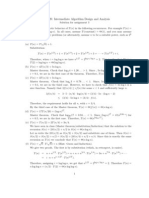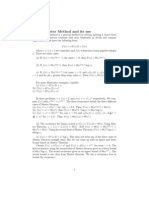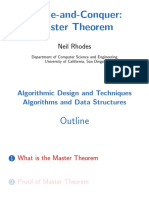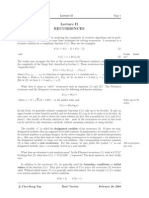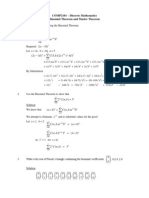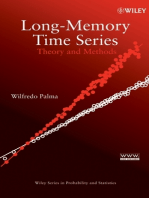Master Theorem: in The Following, Denotes Either Given and in The Case of The Ceiling Function, The Initial Condition
Master Theorem: in The Following, Denotes Either Given and in The Case of The Ceiling Function, The Initial Condition
Uploaded by
Cái BúaCopyright:
Available Formats
Master Theorem: in The Following, Denotes Either Given and in The Case of The Ceiling Function, The Initial Condition
Master Theorem: in The Following, Denotes Either Given and in The Case of The Ceiling Function, The Initial Condition
Uploaded by
Cái BúaOriginal Title
Copyright
Available Formats
Share this document
Did you find this document useful?
Is this content inappropriate?
Copyright:
Available Formats
Master Theorem: in The Following, Denotes Either Given and in The Case of The Ceiling Function, The Initial Condition
Master Theorem: in The Following, Denotes Either Given and in The Case of The Ceiling Function, The Initial Condition
Uploaded by
Cái BúaCopyright:
Available Formats
Master Theorem
Theorem 0.1 (Master Theorem) Let a, b, and k be integers satisfying a 1, b 2, and k 0.1 In the following, n denotes either n or n . In the case of the oor function, the initial condition T (0) = u is b b b given; and in the case of the ceiling function, the initial condition T (1) = u is given.
Upper Bound: If T (n) aT (n/b) + f (n) and f (n) = O(nk ), then O(nk ) O(nk log n) T (n) = O(nlogb a ) if a < bk , if a = bk , if a > bk .
Lower Bound: If T (n) aT (n/b) + f (n) and f (n) = (nk ), then (nk ) (nk log n) T (n) = (nlogb a ) if a < bk , if a = bk , if a > bk .
Exact: If T (n) = aT (n/b) + f (n) and f (n) = (nk ), then (nk ) (nk log n) T (n) = (nlogb a ) if a < bk , if a = bk , if a > bk .
1 More general version of this theorem are known. For example, the theorem is correct if a and b are any real numbers satisfying a 1 and b > 1.
You might also like
- A1 SolutionDocument5 pagesA1 SolutionGraciela MarquesNo ratings yet
- Calculus ApplicationsDocument19 pagesCalculus ApplicationsJunaidNo ratings yet
- COMP2230 Introduction To Algorithmics: A/Prof Ljiljana BrankovicDocument39 pagesCOMP2230 Introduction To Algorithmics: A/Prof Ljiljana BrankovicMrZaggyNo ratings yet
- Master Theorem: Chen Dan Dong Feb. 19, 2013Document13 pagesMaster Theorem: Chen Dan Dong Feb. 19, 2013Pallab KumarNo ratings yet
- Extended Master TheoremDocument3 pagesExtended Master TheoremEkta SinghNo ratings yet
- Ex 3 SolDocument3 pagesEx 3 SolNarbeh MirzaeiNo ratings yet
- Master Method Cheat SheetDocument2 pagesMaster Method Cheat SheetThamizhselvi AmbeesanNo ratings yet
- CSE 5311 Homework 1 Solution: Problem 2.2-1Document8 pagesCSE 5311 Homework 1 Solution: Problem 2.2-1tilahun0% (1)
- Time - Complexity Analysis For Some AlgorithmsDocument8 pagesTime - Complexity Analysis For Some AlgorithmsJorge CastilloNo ratings yet
- 2 MergesortDocument43 pages2 Mergesortarastogi1997No ratings yet
- Algorithms For Data Science: CSOR W4246Document42 pagesAlgorithms For Data Science: CSOR W4246Rishabh ShuklaNo ratings yet
- Lecture 3Document15 pagesLecture 3werhmeisterNo ratings yet
- Unit I Introduction To Algoritm Design Session - 8Document7 pagesUnit I Introduction To Algoritm Design Session - 8Cooldude 69No ratings yet
- Tutorial1 SolutionsDocument4 pagesTutorial1 Solutionsjohn doeNo ratings yet
- Design and Analysis of Algorithms: RecursionDocument20 pagesDesign and Analysis of Algorithms: RecursionTalha KhalidNo ratings yet
- Lecture3 PDFDocument15 pagesLecture3 PDFblackhatson13No ratings yet
- - Algorithm And Complexity - Uma MadamDocument17 pages- Algorithm And Complexity - Uma MadamKarthik NadarNo ratings yet
- CS 332: Algorithms: Merge Sort Solving Recurrences The Master TheoremDocument27 pagesCS 332: Algorithms: Merge Sort Solving Recurrences The Master TheoremAnonymous niE5VQOHNo ratings yet
- Recurrence and Master TheoremDocument35 pagesRecurrence and Master Theoremwseries50% (2)
- MasterDocument1 pageMasterSaint-Clair LimaNo ratings yet
- Ad Endsem ImpDocument27 pagesAd Endsem Impanshuman tripathy-7008No ratings yet
- Assign1 SolutionsDocument6 pagesAssign1 SolutionsMarwan RamounNo ratings yet
- Analysis of Algorithms II: The Recursive CaseDocument28 pagesAnalysis of Algorithms II: The Recursive CaseKamakhya GuptaNo ratings yet
- Mathematical Foundation: CSE 6331 Algorithms Steve LaiDocument23 pagesMathematical Foundation: CSE 6331 Algorithms Steve Laiarup sarkerNo ratings yet
- Divide and ConquerDocument4 pagesDivide and ConquerSaba SuhailNo ratings yet
- Algorithms AssignmentDocument2 pagesAlgorithms AssignmentSerene InNo ratings yet
- Divide and ConquerDocument4 pagesDivide and ConquerAli AliNo ratings yet
- Control LabilityDocument4 pagesControl LabilityhoilololNo ratings yet
- Algorithms 1Document10 pagesAlgorithms 1reema alafifiNo ratings yet
- FALLSEM2022-23 BCSE202L TH VL2022230103397 Reference Material I 26-07-2022 MODULE 1 - Asymptotic Notations and Orders of GrowthDocument19 pagesFALLSEM2022-23 BCSE202L TH VL2022230103397 Reference Material I 26-07-2022 MODULE 1 - Asymptotic Notations and Orders of GrowthUrjoshi AichNo ratings yet
- The Master Method and Its Use: Log A Ǫ Log ADocument2 pagesThe Master Method and Its Use: Log A Ǫ Log AvvvvickyNo ratings yet
- Problem Set 2 SolDocument7 pagesProblem Set 2 SolsristisagarNo ratings yet
- CMSC-5343 Algorithm Analysis Homework 1Document1 pageCMSC-5343 Algorithm Analysis Homework 1Robin AwalNo ratings yet
- Tutorial1 373Document2 pagesTutorial1 373john doeNo ratings yet
- 33 - BD - Data Structures and Algorithms - Narasimha KarumanchiDocument12 pages33 - BD - Data Structures and Algorithms - Narasimha KarumanchiTritonCPCNo ratings yet
- Pset 01Document9 pagesPset 01Yeon Jin Grace LeeNo ratings yet
- Properties of Big-Oh Notation: Dale RobertsDocument14 pagesProperties of Big-Oh Notation: Dale Robertsramurama12No ratings yet
- 3 Divideandconquer 3 MastertheoremDocument76 pages3 Divideandconquer 3 MastertheoremADITYANo ratings yet
- Complexity Analysis - Difficult Recurrences: Example 1: The Fibonacci RecurrenceDocument4 pagesComplexity Analysis - Difficult Recurrences: Example 1: The Fibonacci RecurrenceKoutheir EBNo ratings yet
- Data Structures and Algorithms: (CS210/ESO207/ESO211)Document22 pagesData Structures and Algorithms: (CS210/ESO207/ESO211)Moazzam HussainNo ratings yet
- 03 Divide and Conquer 3 Master TheoremDocument76 pages03 Divide and Conquer 3 Master TheoremKINGS entertainment KHANNo ratings yet
- Lnav 5 N 2 P 201Document10 pagesLnav 5 N 2 P 201satitz chongNo ratings yet
- Algorithm AssignmentDocument7 pagesAlgorithm Assignmentzayn alabidinNo ratings yet
- Algorithm Analysis Big OhDocument15 pagesAlgorithm Analysis Big OhLaxman AdhikariNo ratings yet
- Tut 10Document1 pageTut 10Shriom Kumar SinghNo ratings yet
- Adaptive Lecture04 2005Document28 pagesAdaptive Lecture04 2005Cuter HsuNo ratings yet
- Problem Set 6Document3 pagesProblem Set 6C.Z FuNo ratings yet
- RecurrencesDocument49 pagesRecurrenceskok_oc25No ratings yet
- Chapter 2Document10 pagesChapter 2Anonymous j817fgpimNo ratings yet
- Algo NotesDocument25 pagesAlgo NotesShivangi AgrawalNo ratings yet
- Master TheoremDocument4 pagesMaster Theoremhaseeb juttNo ratings yet
- Lec_3 Asymptotic notationsDocument20 pagesLec_3 Asymptotic notationsamrayyad728No ratings yet
- H3-Solution (WWW Alirezaweb Com) PDFDocument2 pagesH3-Solution (WWW Alirezaweb Com) PDFVahid EsmaeilzadehNo ratings yet
- B A K N C B A: COMP2101 - Discrete Mathematics Binomial Theorem and Master TheoremDocument5 pagesB A K N C B A: COMP2101 - Discrete Mathematics Binomial Theorem and Master TheoremjevanjuniorNo ratings yet
- Course Notes 2: N I 1 N (n+1) 2Document7 pagesCourse Notes 2: N I 1 N (n+1) 2MariaNo ratings yet
- Imo 2004SLDocument36 pagesImo 2004SLlop6c2020cxhNo ratings yet
- There are mainly three asymptotic notations: 1.Big-O Notation (O-notation) 2.Omega Notation (Ω-notation) 3.Theta Notation (Θ-notation)Document15 pagesThere are mainly three asymptotic notations: 1.Big-O Notation (O-notation) 2.Omega Notation (Ω-notation) 3.Theta Notation (Θ-notation)meranaamsarthakhaiNo ratings yet





